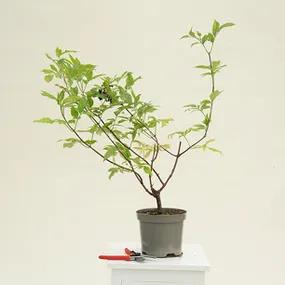Golden Elder Hedge Plants
Honest Delivery PricesSambucus nigra Aurea
60-80cms Hedge Plants- Rich yellow leaves, grows anywhere.
- Rough screening plant.
- Max. Height: 4m
- Bareroot Delivery Only: Nov-Mar.
Recommended extras
Description
Sambucus nigra Aurea: Bareroot Golden Elder Hedging Plants
Sambucus nigra Aurea, is probably the best native golden leaved shrub. Apart from the bight leaf colour and flaming-wavy leaf shape, it's functionally the same as the common elderflower, and it makes a tall, shrubby hedge all by itself.
It looks good as the low maintenance back of a border, filling up the edges of woodland, or as part of a windbreak.
We also grow wild elderflower, which is recommended for making elderflower cordial. Browse our range of hedging.
Delivery season: Elders are delivered bareroot during late autumn and winter, approximately November-March inclusive.
Features:
- Height: 4m
- Soil: Any
- Use: Informal screening, country garden hedging, back of border
- Colour: Mass of bright yellow-green foliage
- Bareroot delivery only: November-March
Growing Golden Elder
It will grow pretty much anywhere. Elder's extreme flexibility and lack of fussiness are famous, but you will get the finest leaf colour with a decent amount of sun.
Pruning your shrubs back in spring keeps lush new foliage coming, which is the main attraction for most people. It also removes flowers and future fruit.
Hard prune in winter to tidy when required.
Spacing a Golden Elder hedge: Plant at 2-3 plants per metre, 33-50cm apart. Wider spacing pays off in time because at either spacing, it's only a matter of time before they make a pretty solid wall.
It is aggressive and is not recommended for a mixed country hedge. It will never form a tidy, formal hedge and looks best when it is allowed to get a bit overgrown.
Planting Instructions
Growing Golden Elder plants:
Golden Elder will grow well in just about any conditions. They thrive on shallow chalk and heavy clay. They will grow in pretty waterlogged sites and tolerate shade, although they won't make many flowers in full shade. It can grow near to the sea and in polluted urban sites.
Prepare your site before planting:
Native hedge plants like Golden Elder are very tough. The only essential preparation is to kill the weeds in a strip a metre wide along the planting site: improving the soil should not be necessary. If your soil is exceptionally poor and dry, then digging in some well rotted manure and/or compost is worthwhile.
Watch our video on how to plant a country hedge for full details. The instruction to cut the plants in half after planting only applies to thorny native hedging and plants in the conservation hedge mix: this isn't necessary for Golden Elder.
Remember to water establishing plants during dry weather for at least a year after planting.
Hedge Planting Accessories:
Prepare your site for planting by killing the weeds and grass
You can buy a hedge planting pack with sheets of mulch fabric and pegs to hold it down.
If you are planting in an area with rabbit and/or deer, you will need to use a plastic spiral guard for each plant, supported by a bamboo cane.
If your soil quality is poor, we recommend using mycorrhizal "friendly fungi" on the roots of new trees and shrubs.
You can also improve your soil with bonemeal organic fertiliser.
After you have planted your Golden Elder hedge, the most important thing to do is water it in dry weather. You will also need to weed around the plants. Watering should be thorough, so the ground is soaked. Let the soil almost dry out before watering again. Watering & weeding will be necessary for at least a year after planting.
Trimming Golden Elder hedge plants:
From the winter after planting onwards, your young hedge should be trimmed lightly once every winter, until it is mature. When it is fully grown, you can clip it at anytime. It can be hard pruned if necessary.
Special notes on caring for Golden Elder hedges:
Golden Elder is a very tough hedge plant that shouldn't need special attention once it has established. If you didn't use a mulch fabric, it is beneficial to mulch around the base of the hedge each year with well rotted manure or compost.
Hygiene & Diseases:
Dead, damaged or diseased wood can be pruned off as soon as it appears.
Disinfect your pruning tools between every cut if there is any sign of disease.
Burn or dispose of any diseased material, do not compost it.
Did You Know?
This variety was recorded in 1883, and there is a likelihood that it is the same plant as S. nigra aurea Dixonii.

 1.webp)
 1.webp)
 2.webp)

 3.webp)
